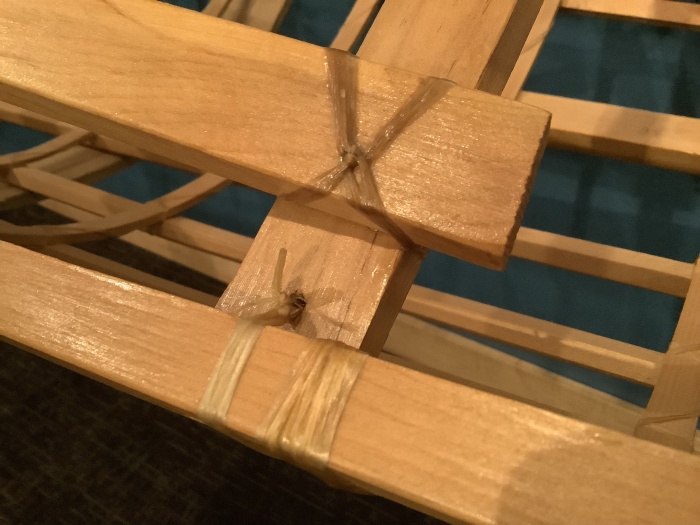Lashed (to be) — Nemrulluku
Nemrusgu kicaq.—Tie up the anchor.

Photo: Lashing on a kayak frame by Alfred Naumoff, purchased with support of Rasmuson Foundation, AM751
The Alutiiq verb for lashing, nemrulluku, means to be tied to something. It indicates that two or more things are joined together. Lashing was an important, widely used skill in classical Alutiiq society. Many of the implements used in daily life were made with multiple, joined pieces. Lashing was an important part of manufacturing everything from fishhooks and harpoons to boats, buckets, and masks. It was also used to repair broken objects by tying them back together.
Common lashing materials included sinew, spruce roots, baleen, and leather, materials with strong, flexible fibers that could be wound and tied. Grass, hair, and kelp were also likely used, and occasionally, people wrapped bark around the area where two parts of a tool joined, and then lashed over the bark. This helped to keep the lashing from slipping, particularly as bark swells when wet. Many tools feature a hole for lashing or a knob or groove to hold lashings in place. For example, some slate knives were drilled to create a hole for securing a handle to the blade. Similarly, adzes had pecked grooves over the top to hold lashing used to secure the stone bit to a wooden handle.
Common lashing materials included sinew, spruce roots, baleen, and leather, materials with strong, flexible fibers that could be wound and tied. Grass, hair, and kelp were also likely used, and occasionally, people wrapped bark around the area where two parts of a tool joined, and then lashed over the bark. This helped to keep the lashing from slipping, particularly as bark swells when wet. Many tools feature a hole for lashing or a knob or groove to hold lashings in place. For example, some slate knives were drilled to create a hole for securing a handle to the blade. Similarly, adzes had pecked grooves over the top to hold lashing used to secure the stone bit to a wooden handle.
